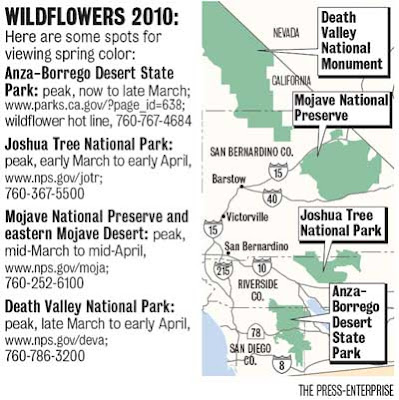

Spring color has erupted in the lower elevations of Anza-Borrego Desert State Park and is beginning at Joshua Tree National Park. The display, sprinkled with red chuparosa and delicate pink sand verbena, is expected to intensify in the coming weeks.
Some wildflower watchers say this spring's blooms could be less spectacular because September, October and November lacked rain needed to kick-start germination. But others disagree and say the regular blasts of winter rain will make for a better-than-average wildflower season, once the weather warms.
"We had ample rains in January. What that will do, and what we're going to see, is widespread bloom," said botanist Jim Andre, director of UC Riverside's Sweeney Granite Mountains Desert Research Center in the Mojave National Preserve. "You can't really lose this year."
Predicting the success of a wildflower season is tricky, he said, because so many factors influence the plants' behavior.
Besides rain, the flowers need warm temperatures and depend on the bank of seeds stored by each plant. Those in the Colorado Desert, which includes Anza, the Coachella Valley and the eastern part of Joshua Tree, require autumn rain, but the transition zones covering other parts of Joshua Tree, Death Valley and the Mojave National Preserve do not, he said.
Andre and other experts agree that this season could be slightly later than usual because of the winter storms.
Andre expects Joshua Tree will have one of the most spectacular displays this year. The area received 10 inches of rain in some spots, more than an average year's total. But germination could be slowed by future rain and snow because the seeds could rot or wash away, he said.
Here what's happening now:
In Anza, pockets of verbena and desert lilies are blooming outside Borrego Springs. At the peak of the season, look for carpet-like blooms of those and desert sunflowers along Henderson Canyon Road and Coyote Canyon, said Jim Bremner, who tracks sightings on his Web site, DesertUSA.com. Wildflowers to come include brown-eyed primrose, Arizona lupine, desert lavender and California trixis. The peak: now to late March.
On the warmer, low-desert side of Joshua Tree, near the Cottonwood Visitor's Center, chuparosa, bladderpod and ocotillo are starting to bloom, ranger Joe Zarki said. This month, expect to see the blooms of yuccas, nolinas, beavertail cactus, wooly marigolds, sunflowers, desert dandelions, blue-flowered heliotrope and poppies at the park and Amboy Crater. The peak: the second week of March to early April.
In the higher-elevation eastern Mojave Desert and Mojave National Preserve, blooms haven't started yet. In the next few weeks, look for desert pincushion, Canterbury bells, desert gold, Bigelow's monkeyflower and apricot mallow. Some of the best spots are the Cima cinder cones outside Baker and the Kelso Dunes. The peak: mid-March to mid-April.
In Death Valley, wildflower sprouts have started to appear in the lower elevations of the park. Though still a long way from flowering, the most growth is in the central part of the valley, lending a green tint to the alluvial fans and hillsides. Expect to see the pink blossoms of beavertail cactus, rock nettle, globemallow and Bigelow coreopsis. The peak: late March to early April.
© 2010 [Subscriber] and its licensors.
Portions © 20010 Bring the Blog,
LLC and used with permission.
All rights reserved.
Do not reproduce without permission.

No comments:
Post a Comment